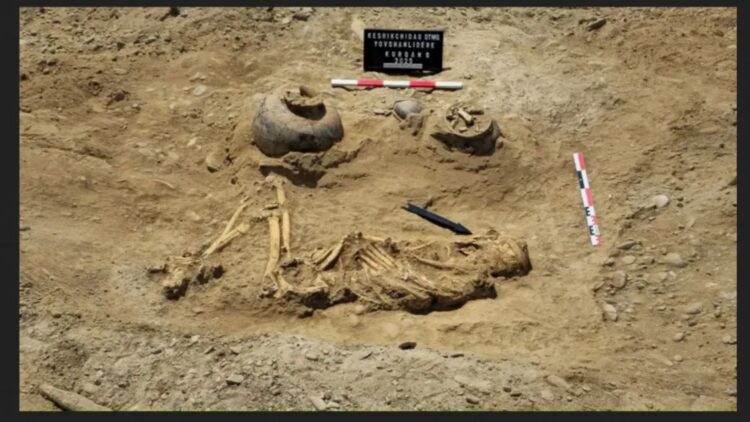The plains of Ceyranchol, west of Azerbaijan, near the current borders with Georgia and Armenia, have made a discovery of significant value for Archeology and the history of our civilizations. It is none other than the tomb belonging to a warrior from the Bronze Age. The exact location of the discovery is the state historical and cultural reserve of Keşikçidağ, protected for its archaeological and natural value. In it, the kurgans, funeral mounds built from the Bronze Age to the Iron Age, can be found.
The mound divided into three, the position of the warrior, and the bronze spear with a four-pronged tip that he held in his hands stood out, indicating that his status belonged to that of a military leader or a figure of prestige. Bronze ornaments, obsidian carved tools, and twelve decorated ceramic jugs were also found alongside the body.
The place where the tomb was discovered houses natural and artificial cavities that served as dwellings, shelters, and during the colonization of Christianity, also as improvised churches. The value and the amount of information provided by this discovery includes data on funerary practices of the Middle Bronze Age in the Western Caucasus. Furthermore, it also helps to understand the cultural and symbolic complexity that characterized these communities.
A giant warrior has been found
The existence of giants can be found in many of the historical sources we have. Biblical texts, Norse sagas, and fairies in modern myths. However, the latest discovery is one of the most real pieces of evidence. It depicts the discovery of the tomb of a warrior from 3,800 years ago, at a time when the average male height was below 2 meters, which is why he was considered a giant.
This fact takes us to the plains of Ceyranchol, to the west of Azerbaijan, near the current borders with Georgia and Armenia. It is a state historical-cultural reserve of Keşikçidağ, which is an area protected for its high archaeological and natural value. It is in this region where the kurgans are located, funeral mounds dating from the Bronze Age to the Iron Age.
Tomb of the warrior
The warrior’s grave was found in a burial mound more than 28 meters in diameter. It was a burial chamber divided into three distinct spaces. The first contained the body – which symbolized the separation from the world of the living -, the second held ceramic vessels – considered provisions for the afterlife -, and the third was empty – which represented the space destined for the unknown -.
The semi-flexed position of the warrior’s body was striking, as was the presence of a bronze spear with a four-pronged tip. According to experts, this symbolized his superior status; he could have been a military man or a figure of prestige. Bronze ornaments, glass beads, tools carved from obsidian, and ceramic jars were also found next to the body. Experts assert that this is not a random arrangement, but rather everything corresponds to a premeditated action.
A protected region
This area parallel to the Georgian border has altitudes between 750-950 meters above sea level. It also includes natural and artificial cavities that once served as shelters, homes, sanctuaries, and even tombs. When the time came for the colonization of Christianity, they became makeshift churches. This fortress known as ‘The Sentinel Castle’ (Keşikçi qala) is considered by experts as a main element of the landscape that had defensive and symbolic functions.
Legacy of the ‘giant’ of Keşikçidağ
The value that this finding has brought to Archaeology and to the history of the civilizations that preceded us is incalculable. This tomb has provided data on the funeral practices that were carried out in the Middle Bronze Age in the western Caucasus, as well as helping us appreciate the cultural and symbolic complexity that these communities exhibited. Aspects such as the four-pointed spear, food remains, and the division of the tomb into three spaces help us understand the way in which civilization understood life.
Find out about other valuable discoveries from ancient civilizations!
